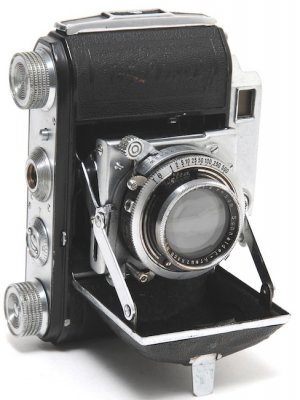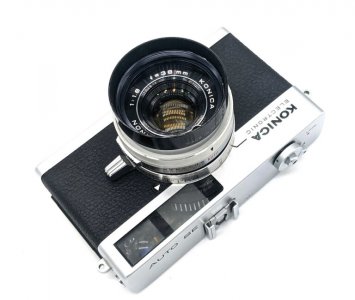Jason Schneider
the Camera Collector
Compact Fast Lensed Rangefinder 35mm Cameras, part 2
Rrangefinder 35s pack maxi picture power into mini form factors!
By Jason Schneider
I wish there were a less ponderous term than “noninterchangeable lens” for describing cameras lacking lens switching capability, but “fixed lens” gives the wrong impression, so I guess we’re stuck with it. The acronym, NIL, doesn’t thrill me either, but I will use it for concision going forward. NIL rangefinder 35s have a noble history going back to the late ‘30s (though some were based on earlier roll film models) and several were offered with f/2 lenses. The species continued in the early postwar years, mostly with light revisions to prewar designs, but now fitted with coated lenses in MX sync shutters, and with other refinements. The apotheosis of this engaging breed burst forth during the ‘60s and ‘70s, with major Japanese companies including Canon, Olympus, Minolta, Konica, and Yashica releasing a slew of amazing NIL rangefinder 35s with fast 6- and 7-element lenses in the f/1.7 to f/2 range and offering such advanced features as autoexposure plus full manual settings, electronically controlled shutters, viewfinders with projected, parallax compensating finder frame lines, and even dual metering modes. Not every model had everything of course, but the performance and versatility of these cameras makes them superb choices for anyone wanting to experience the joys of analog photography without having to spring for a Leica M, a Nikon SP, or a Canon 7sZ. Here’s a brief rundown in (more or less) chronological order:
Note: I’ve placed a little star in front of the names of my personal favorites.
Fast folders: Early NIL rangefinder 35s with f/2 lenses
Weltini I and II: Made by Welta, a German camera maker located in Freital, near Dresden, the Weltini is based on the Welti, a scale focusing, folding 35, but added a coupled range/viewfinder to what would have been the Welti’s bottom plate! The resulting “upside-down Welti” has the advance knob, rewind knob, and frame counter on the bottom, a left-handed shutter release, a swing back hinged on the left, and a film release on the right. The film feeds “backwards” compared to the Welti. One fascinating feature: the Weltini’s focusing lever automatically returns to infinity position as you close the folding bed, neatly preventing potential camera crunching disasters that occasionally occur with other folders.
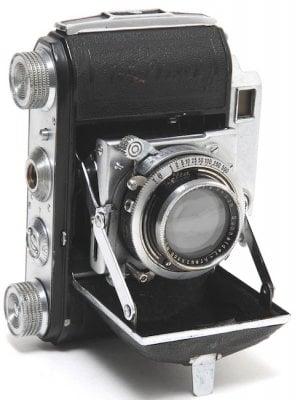
Prewar Weltini I with uncoated 50mm f/2 Schneider Xenon lens in Compur-Rapid shutter. A great choice for capturing vintage look images.
Twi variants exist: the Weltini I with squared off top range/viewfinder housing (1937 to 1938) and the later, more common version II with a rounded top plate (1938 to 1941). Both have a depth of field table on top, and neither had an accessory shoe. While the design was admittedly “clever” and saved in production costs, many find these cameras “awkward” to use. However, the Weltini is generally acknowledged to be well made, reliable, and capable of capturing excellent images. Most often fitted with an uncoated 50mm f/2.8 Schneider Xenar or Carl Zeiss Jena Tessar, both versions were also available with an uncoated 50mm f/2 Schneider Xenon, a fast, sharp, 6-element, 4-group design that delivers beautiful “vintage look” images. Collectors with deep pockets will keep an eye out for a Weltini with a 50mm f/3.5 Leitz Elmar. You can snag a clean, functional Weltini with a 50mm f/2.8 or 50mm f/2 lens for around $125.00 to $225.00. One with an Elmar will set you back $500.00 to $600.00. Good hunting!
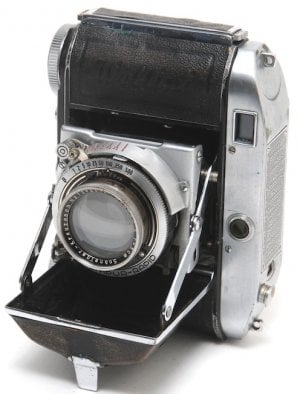
Weltini II with uncoated 50mm f/2 Schneider Xenon lens in Compur-Rapid shutter. It's basically a sleeker more attractive version of the Weltini I.
Certo Dollina II: Certo, a German camera maker based in Johannstadt, a suburb of Dresden, was founded in 1902, and during the ‘20s it produced several well-regarded medium-priced, roll film folding cameras. Responding to the burgeoning interest in 35mm photography, Certo brought forth the Dollina, a horizontal-bed, scale-focusing folding 35 with a simple viewfinder in 1935 and about 2 years later introduced its best-known model the Certo Dollina II, which added a coupled split-image rangefinder with separate viewfinder eyepiece on the top deck. The rangefinder is operated by a cam on the underside of the focusing knob which pushes a stud on the rangefinder body forward as the focus moves toward infinity, a delicate assembly that can easily be knocked out of whack by rough handing. However, when handled with a modicum of respect, the Dollina II, while not the last word in terms of convenience, is an attractive, well-made camera capable of outstanding results. It was available in black enamel finish (early models) or chrome, and in 1938 you could acquire a Certo Dollina II with uncoated 45mm f/2.0 Schneider Xenon lens in a Compur Rapid 1-1/500 sec plus T and B shutter in New York for $57 50. This is equivalent to a staggering $1,246.79 in 2024 dollars, but that was still only about half the price of a Xenon lensed Retina II or Weltini!
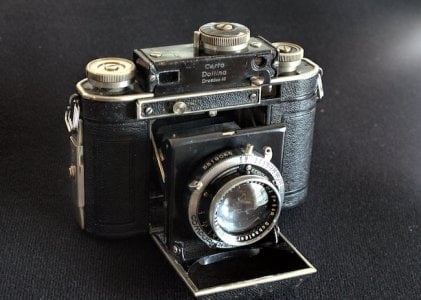
Certo Dollina II c. 1937 with uncoated 50mm f/2 Xenon. It was less cnveient (an less expensive) than a Weltini but it has its charms/
The elegantly baroque Certo Dollina III of 1939 was similar in concept to the Dollina II, and available with an uncoated 50mm f/2 Schneider Xenon. The last of the breed, the prewar Super Dollina and the postwar Super Dollina II, had a rounded, more compact body design and were available with an uncoated 50mm f/2 Xenon in a Compur-Rapid shutter and a coated 50mm f/2 Rodenstock Heligon in a Synchro-Compur 1-1/500 shutter. The last run of Super Dollina IIs were often fitted with a coated 50mm f/2.8 Zeiss Jena Tessar lens in an East German Vebur shutter. Prices of a used Certo Dollina (all iterations) vary widely, but you can generally pick up a clean Certo Dollina II with Tessar for $50.00 to $100.00, and a Certo Dollina III with 50mmm f/2.0 Xenon for $150.00 to $300.00; higher for rare mint condition examples.
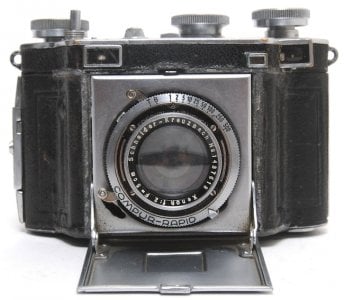
Certo Dollina III with uncoated 50mm f/2 Schneider Xenon lens in Compur-Rapid shutter. Baroque styling but same specs as the Dollina II.
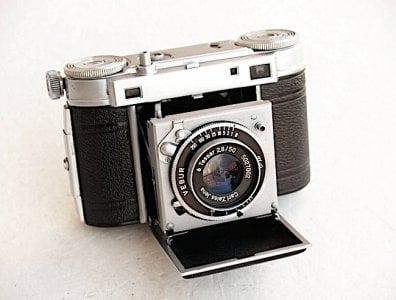
Late model postwar Super Dollina II with 50mm f/2.8 Jena Tessar lens in 1-1/250 sec pus B Vebur shutter. Note unique focusing knob, top left.
*Kodak Retina II and IIa: Produced by the Nagel factory in Stuttgart, a company acquired by Eastman Kodak Co. in 1931, the Retina name is most closely associated with a long-running series of robust, beautifully made, high-performance folding 35mm cameras, including a full range of models with built-in coupled rangefinders. The first rangefinder Retina was the rare Retina II (Type 122) of 1936 to 1937, which had a built-in, coupled long base rangefinder, a separate viewfinder, and was available with an uncoated 50mm f/2.0 Schneider Xenon lens, a 50mm f/3.5 Kodak Extar, or a 50mm f/2.8 Xenar, all in 1-1/500 sec plus B Compur-Rapid shutters. It was also the first 35mm camera in the world with a top-mounted film wind lever, albeit a short, stubby one, but it proved to be troublesome and the Type 122 was discontinued after only one year of production, and replaced by the much more common Retina II (Type 142), basically the same camera with a conventional wind knob and the same choice of lens/shutter units. The Retina II line continued after the war with the Retina II (type 011) of 1946 to 1949 which features a more convenient combined range/viewfinder with a single eyepiece, a (rare) coated 47mm f/2 Ektar, a (more common) 50mm f/2 Xenon, or a 50mm f/2 Rodenstock Heligon lens that was more commonly fitted to European market cameras. The Retina II (Type 014) of 1949 to 1950 is virtually the same as the Type 011 but adds a PC flash sync terminal. The last of the small-bodied rangefinder Retinas (all subsequent c- and C-series Retina folders had larger, thicker bodies) was the Retina IIa (Type 016), manufactured from 1951 to 1954. It was originally fitted with a Compur-Rapid shutter, but the more common later version features a Syncrho-Compur 1-1/500 sec plus B shutter with MX sync. The postwar Retina IIa’s signature feature is a top-mounted single stroke film wind lever, and that’s one reason many savvy users consider the 50mm f/2 Xenon-lensed version of the Retina IIa the best folding rangefinder Retina ever. Others note that the IIa’s frame counter is delicate and hard to repair (since parts are no longer available) and claim thar the knob wind Retina II (Type 014) is more reliable. They’re both great user collectibles capable of first-rate performance so you pay your money and take your choice!
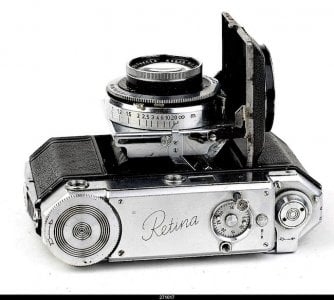
Rare Kodak Retina II, (Type 122), top view, showing innovative stubby wind lever. it was replaced by more reliable (Type 142) with knob wind.
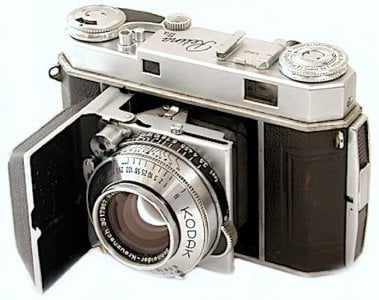
Kodak Retina IIa with coated 50mm f/2 Schneider Xenon. Many say it's the best of the breed, combining compactness and high performance.
Clean Kodak Retina II cameras (all versions except for the Type 122) are widely available in clean working condition at prices ranging from $60.00 to $125.00 (up to $225 fir mint examples) and are among the best buys for vintage film shooters. Pristine Retina II’s sporting the rare (and superb) 47mm f/2 Ektar lens are collector’s prizes that go for $500 on up, and since there are only about 200-300 known examples of the Retina II (Type 122). prices run around $800.00 to $1,200.00 when they show up online. Note: If compactness and lens speed are not that important to you, the bulkier Retina IIc and IIC (no meter, available with the superb 50mm f/2.8 Xenon or Heligon lens) are great shooters as are the Retina IIIc and IIIC both with component interchangeable lenses, built-in uncoupled selenium meters, and typically fitted with 50mm f/2 Xenon lenses. The Retina IIIC (large C) of 1957-1961, the last of the folding Retinas, has an excellent high magnification multi-frame viewfinder (all 3 reflected frame lines are visible at once). Like all c- and C-series models it’s chunky but a great shooter. Current estimated used price ranges: Retina IIc, $50.00 to $100.00; Retina IIC (rare), $75.00 to $135.00; Retina IIIc with 50mm f/2 Xenon, $90.00 to $140/00: Retina IIIC with 50mm f/2 Xenon, $250.00 to $350.00.
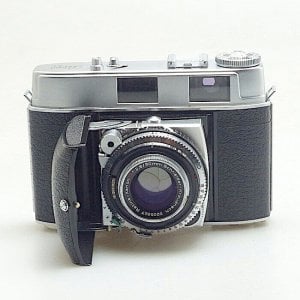
Uncommon Kodak Retina IIC (large C) with superb 50mm f/2.8 Schneider Xenon lens in Synchro-Compur shutter. It's a keeper!
Agfa Karat 36: Based on the postwar version of the Karat 12, a folding camera with a split-image rangefinder that took Agfa Rapid cartridges, the Karat 36, released in 1948 and in production in the ‘50s, takes regular 35mm film cartridges, and provides a standard 24 x 36mm format. Like the Karat 12’s it has a unique full image area split-image rangefinder, a small bellows behind the lens unit, and extends the font standard to shooting position on two robust spring-loaded scissors struts. It added a rewind knob, employs an unusual “imbedded” film advance lever with a front-to-back motion, and was available with a choice of 5 lenses, a 4-element 50mm f/2.8 Agfa Solinar, a 50mm f/2.8 Schneider Xenar, or a 6-element 50mm f/2 Schneider Xenon, Agfa Solagon, or Rodenstiok Heligon, all fine performers, each with slightly different rendition. Early examples of the Karat 36 have Compur-Rapid shutters with X sync; later ones are fitted with Synchro-Compur shutters with MX sync; both provide speeds of 1-1/500 sec plus B. In 1954 Agfa released the Agfa Karat IV, which has a conventional superimposed image range/viewfinder, a Prontor SVS shutter with a top speed if 1/300 sec, and the same choice of lenses except for the 50mm f/2.8 Xenar, which was evidently dropped on that model.
All these Agfas are beautifully made and finished, fitted with fine lenses, and capable of outstanding on-film oerfirmance. Used ones are somewhat more likely than, say, Retinas to require repairs, so make sure the one you buy is fully functional and that the seller offers return privileges with a full refund if you’re not satisfied. You can generally snag a clean working Karat 36 or Karat IV with 50mm f/2.8 Solinar or Xenar lens for $50.00 to $100.00, and one with a 50mm f/2 Xenon for around $125.00 to $150.00. Examples with 50mm f/2 Solagon or Heligon lenses generally fetch about $200.00. Note: These cameras were also marketed under the Ansco brand, with inscriptions noting that they were made in Germany by Agfa. The Karat 36 was also sold as the Karomat, and suitably inscribed on the top.
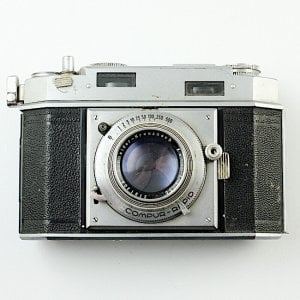
Agfa Karat 36 with coated 50mm f/2.0 Schneider Xenon lens in Compur-Rapid shutter. It had an unusual full-area split-image rangefinder.
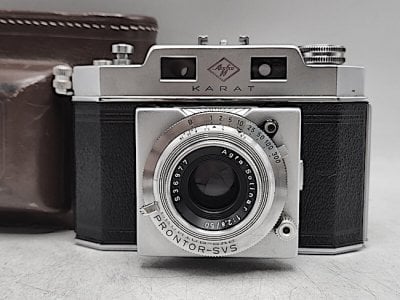
Agfa Karat IV with 50mm f/2.8 Solinar lens in Prontor-SVS shutter. It has a superimposed-image rangefinder in a Karat-style folding body.
Zeiss Tenax II: If your taste runs to the exotic, the Tenax II (model 580/27) of 1938 may be the compact fast lensed rangefinder 35 for you. Though technically this 24 x24mm format beauty is an interchangeable lens camera, very few accessory lenses were made or sold. Optimized for shooting fast sequences you push the large right-handed, front-mounted wind lever downward with your index finger like a plunger, let it spring back, then quickly move your finger back slightly and press the nearby shutter release to take the picture. This fast-firing design, inspired by the spring motor 24 x 24mm Robot I of 1934, was patented by eminent Zeiss camera designer Hubert Nerwin and his team. Other ingenious features: a combined range/viewfinder that moves the secondary image by means of two contra-rotating prism wedges in front of the rangefinder window (like a Zeiss Super Ikonta), and a behind-the-lens Compur Rapid OS leaf shutter with speeds of 1 to 1/400 sec plus B. Standard lenses for the Texax II were an uncoated 4cm f/2 Sonnar or 4cm f/2.8 Tessar, and there was a rare 2.7cm f/4.5 Orthometar wide-angle and a low-prduction7.5cm f/4 Sonnar medium tele, all in a unique bayonet mount. The Tenax II is a collector’s prize but also a highly competent picture taker. As you’d expect a clean working Tenax II with a 4cm f/2 Sonnar ir f/2.8 Tessar runs about $600.00 to $800.00, and one with a 2.7cm f/4.5 Orthometar (a mere 302 units were produced!) fetches $2,200.00 to $4,000.00.
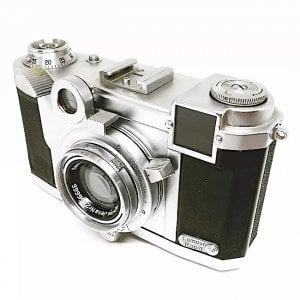
Zeiss Tenax II with 4cm f/2 Sonnar. An awesome fast-firing design with 24 x24mm format, this exotic is technically an interchangeable-lens 35.
*Minolta V2: Named to evoke Wernher von Braun’s iconic V2 rocket, the 1958 Minolta V2’s signature feature was its unique Optiper-Citzen-HS M-10 leaf shutter that provides unprecedented top speeds of 1/1000 and 1/2000 sec at maximum apertures if f/4 and f/8 respectively. The shutter design uses stronger springs to increase the speed of the shutter blades and restricts the overlap of the blades to enable elevated shutter speeds, but only at smaller apertures. The shutter also provides a normal shutter speed range of 1 to 1/500 sec plus B over the full aperture range (f/2 to f/22) of the excellent 6-element, 5-group 45mm f/2 Rokkor-PF lens. The sleekly curvilinear V2 has manual settings only—there’s no built-in meter—but it does offer an excellent combined, coincident type range/viewfinder with a projected parallax compensating frame line in the finder, a nicely contoured film wind lever, was claimed to be the first camera with an LVS system that goes up to 20, and has a dimpled pressure plate to reduce friction, All this was offered at the enticing price of only $99.95 (equal to about $1,066.00 in 2024 dollars). In 1960 the Minolta V2 was succeeded by the Minolta V3 which added a small built-in uncoupled selenium meter shoehorned into the area around the rangefinder window and upped the top shutter speed to 1/3000 sec (but still only at apertures of f/8 or smaller). All other features closely parallel the V2. If you’re tempted, you can acquire either one of these fascinating and adept user collectibles. A Minolta V2 in clean working condition runs about $75.00 to $150.00; the much rarer V3 fetches $200.00 to $250.00.
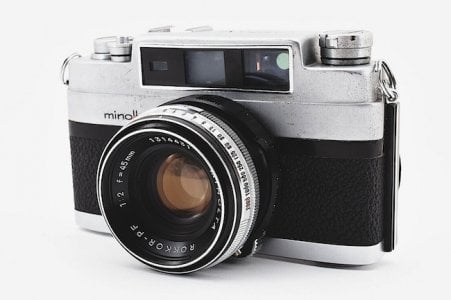
Minolta V2 with 45mm f/2 Rokkor-PF lens has a 1/2000 sec top shutter speed, but it's only available at apertures f/8 and smaller! (see text)
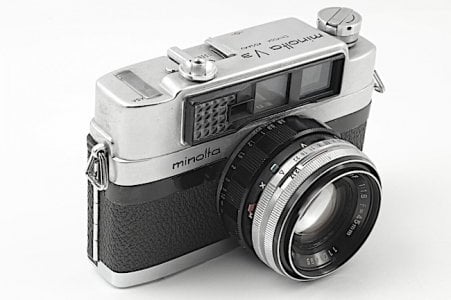
Rare Minolta V3 has built-in selenium cell meter and a 1/3000 sec top shutter speed, but (you guessed it!) its only useable at f/8 and smaller.
*Topcon 35-S and 35-L: These outstanding NIL rangefinder 35s were produced by Tokyo Kogaku (Tokyo Optical Co.) from 1956 to late 1959. The Topcon 35-S was released in 1956 and was in production for only about a year, Ruggedly handsome and straightforward, it ports a superb semi-wide-angle 44mm f/2 Topcor lens (a classic 6-element 4-grouo Double Gauss design) in a Seikosha-MX 1-1/500 sec plus B leaf shutter, features a combined 1:1 range/viewfinder with a parallax-compensating Albada frame line, and has a top-mounted double-stroke wind lever claimed to minimize torn sprocket holes. Very well made, nicely finished and reliable, it has definite collector appeal and is also a fine choice for vintage film shooters.
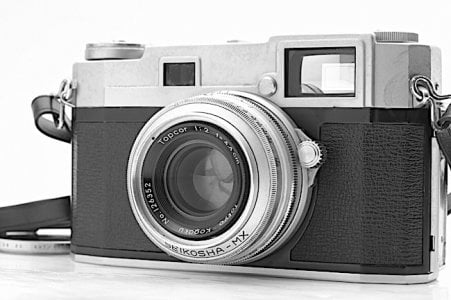
Topcon 35-S. with 4.4cm f.2 Topcor lens in Seikosha MX Shutter. No meter, but a great lens and range/viewfinder and very robust build quality.
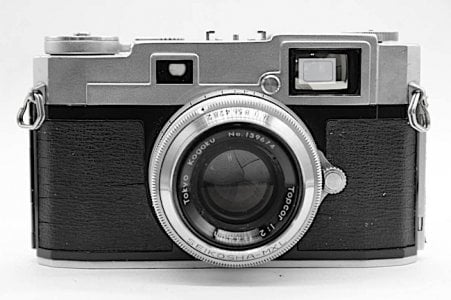
Topcon 35-L. It added a Seikosha-MXL shutter with the then-new LVS coupling system that many vintage camera shooters love to hate.
The Topcon 35-S was replaced by the Topcon 35-L (marketed in the USA as the Beseler Topcon 35-L) in 1957. Its specs are the same as the 35-S except that the shutter was upgraded to the Seikosha-MXL, which featured the then-new LVS coupling system. It was sold with a separate selenium meter that gave readings in Light Value numbers. An economy model, the Topcon 35-JL with a 50mm f/2.8 Topcor lens (a 5-element, 3-group Heliar design) was introduced at the same time as the 35-L, and both were discontinued by the end if 1959, marking the end of Tokyo Optical Co.’s brief foray inti the 35mm rangefinder market. You can acquire one if these fine and distinctive user collectibles in clean working condition for around $100.00 to $150.00.
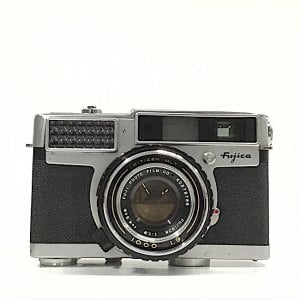
Fujica 35-SE with 4.5cm f/1.9 lens and built-in selenium meter. "1000 1.9" logo below lens marks it as variant with 1/1000 sec top speed.
Fujica 35-SE: A very advanced rangefinder 35 for 1959, it was basically an update of the landmark Fujica 35-ML and retained that camera’s distinctive (and ergonomic) thumbwheel focusing, baseplate film wind lever and side-mounted rewind crank (it’s on the upper left-hand corner with the camera held in shooting position). It has what Fuji described as an “automatic exposure setting electronic light meter,” but that’s just ad lingo for a built-in coupled selenium cell meter that uses a manual “center the needle” system with a top-mounted meter scale. You can grab the aperture and shutter speed rings on the lens barrel and rotate them simultaneously to maintain the same EV. Other key features: large, bright range/viewfinder with projected parallax compensating frame line and excellent central superimposed image rangefinder, outstanding 6-element, 4-group 45mm f/1.8 Fujinon lens in a Fuji Synchro-MXL shutter with a top speed of 1-1/500 sec or 1/1000 sec plus B (there were 2 versions). It’s a fine camera, beautifully made, and with a great lens, but you’ll be lucky to find one with a working meter. Current price range in clean condition with working shutter: $40.00 to $85.00.
Autoexposure rangefinder 35s: Last and most convenient of the breed!
Canonet: The original Canonet of 1961 often gets overlooked in the glitz and glamour of later models like the acclaimed Canonet G-III 17 of 1972, but it was remarkably adept and full featured for its day and set the stage for a generation of compact autoexposure rangefinder cameras that flourished in the ‘70s. Its signature feature is a selenium meter cell placed concentrically around the excellent Canon SE 45mm f/1.9 lens (a 5-element, 4-group Gauss design). Its Copal SLV leaf shutter with speeds from 1 sec. to 1/ 500 plus B&T locks automatically if the light is too low/high, and the camera has a built-in self-timer, and a combined range/viewfinder with a projected parallax-compensating frame line. Beautifully proportioned and very well made, the original Canonet provides shutter priority AE and full manual settings (there’s no metered manual mode) with aperture scale in the viewfinder. Its trigger-style wind lever and rewind crank located unconventionally on the bottom of the body, but this setup works well. Shooters should make sure the camera they buy has film speed settings from ASA 10 to 400 (early examples only go up to ASA 200!). Marks of this camera’s success: initial stocks were sold out in 2 hours after it was released, and within 2-1/2 years a million Canonets had been sold! The original Canonet is a great shooter when it’s working and you can often snag a clean one for $50.00 or even less, but repairs can be costly so caveat emptor.
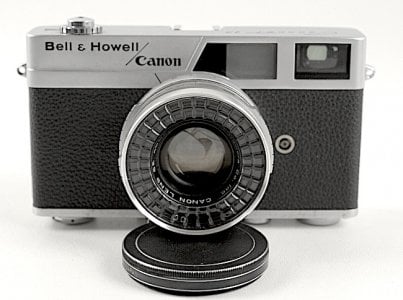
Canonet original, with selenium cell around the 45mm f/1.9 SE Canon lens. This is the dual logo version marketed in the U.S. by Bell & Howell.
The Fujica V2: Released in 1964, this hefty, beautifully made rangefinder 35 is basically an upgraded Fujica 35-SE with the same outstanding 6-element, 4-group 45mm f/1.8 Fujinon lens, thumbwheel focusing down to 3 feet, bottom-mounted wind lever, side mounted rewind crank and great range/viewfinder with a projected parallax compensating frame line and clear coincident-type central rangefinder patch. But instead of a center-the needle, coupled selenium meter, the V2 has a front-mounted CdS metering port set in the distinctive 25 to 400 ASA dial (so it doesn’t automatically compensate for mounted filters), and provides shutter priority autoexposure plus full manual settings, albeit with no in-finder readouts. A red exposure indicator lights up if either or both settings are outside the metering range. The inter-lens leaf shutter is either a Citizen with speeds of 1 to 1/500 sec plus B, or a Citizen MLT with a top speed of 1-1/1000 sec plus B. It’s a superb user/collectible with only 2 downsides: its metering system was designed to take 1.35v PX 13 mercury batteries and must be converted to provide accurate readings with current 1.5v cells, and (inexplicably) the film speed settings top out at a measly ASA 400. If you want to acquire one if these gems in clean working order, be prepared to shell out about $100.00.
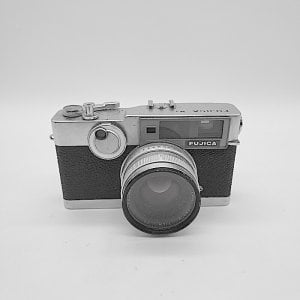
Fujica V2 has a superb 45mm f/1.8 Fujinon lens, thumbwheel focusing, many advanced features, but film speed settings top out at ASA 400?!
Olympus 35 SP: Released in 1969 this audacious rangefinder 35 is the only camera of its kind with dual pattern (center-weighted averaging and spot metering) and is one of the few that provides both shutter priority autoexposure and metering in manual mode—the uncoupled CdS cell meter provides EV readings in the finder which are then translated into shutter speed- and aperture-setting rings on the barrel of the superb 52mm f/1.7 G. Zuiko lens, an advanced 7-element, 4-group design. Apertures range from f/1.7 to f/22 in AE mode and f/1.7 to f/16 in manual mode, the shutter provides speeds of 1 to 1/500 sec plus B with flash sync at all speeds, there’s a handy exposure lock actuated by a half press of the shutter release, and the large, bright range/viewfinder has a crisp frame line with parallax correction marks, but no auto parallax compensation. The lens focuses smoothly down to 2.79 feet using a large, convenient focusing lever, the film speed scale has settings from ASA 25 to 800, and the camera provides accurate auto flash as you focus once you set the film speed and flash guide number. Downsides: Manual metering is inconvenient; the CdS meter cell next to the viewfinder doesn’t automatically compensate for munted filters, the metering system was designed for 1.35v PX 625 mercury cells and must be modified to work properly with current 1.5v batteries, and the meter is only sensitive down to EV3 and locks up when the chosen shutter speed is below 1/15 sec or higher than 1/250 sec. Despite its relatively minor foibles the trendsetting Olympus 35SP is an awesome picture taker and a remarkable achievement for a camera that debuted 55 years ago--and it’s attractive to boot. You can acquire a clean, fully functional example for about $125.00 to $200.00 in silver, about 50 bucks higher in beautiful black.
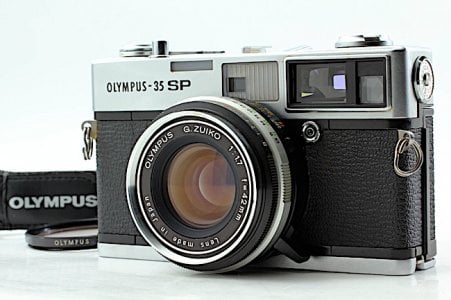
Olympus 35 SP with superb 7-element 42mm f/1.7 G.Zuiko lens had dual mode metering, many more advanced features way back in 1969!
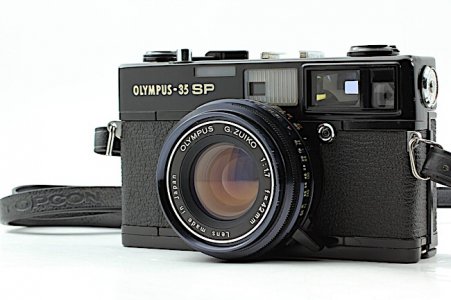
Olympus 35 SP is beautiful in black, but it was produced in smaller quantities and fetches higher prces than the chrome version.
Yashica Electro 35 CC: Released In 1970, it was the only compact rangefinder 35 with a fast true wide-angle lens, a sharp 6-element 4-group 35mm f/1.8 Yashinon DX in an electronically controlled inter-lens leaf shutter with speeds of 8 to 1/250 sec and built in X sync visa the PC outlet only (no hot shoe). The camera provides aperture priority automation using a CdS cell in the lens I.D. ring, thereby automatically compensating for mounted filters, and has under- and over-exposure wanning lights in the finder, but no aperture or shutter speed readouts or manual settings. More compact than the more common Electro 35 GS and GT, the 35 CC has very clear projected finder frame line with markings for parallax compensation, ASA settings from 25 to 500, an excellent short stroke wind lever, a crisp, clear superimposed image rangefinder, and its lens focuses down to a closer than average 2.6 feet. On the downside, flash sync is at 1/30 sec. On the plus side: the metering system is powered by a readily available 6v PX28 battery. In the immortal words of the old Konica ad, “the lens alone is worth the price,” and this stellar high-speed wide-angle goes a long way in compensating for this black beauty’s limitations. Note: Some examples were labeled Yashica Electro 35 CCN Wide). Prices vary widely, but you can generally acquire a clean working example for $75.00 to $150.00.
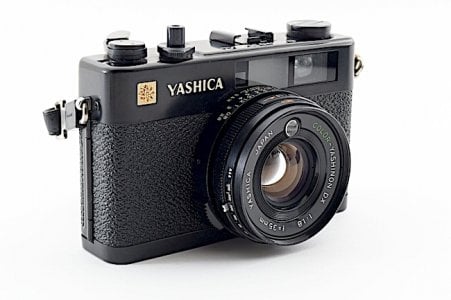
Yashica Elecro 35 CC in black with outstanding wide-angle 35mm f/1.8 Color-Yashinon DX lens is an affordable high-performance classic.
Olympus 35 DC: Introduced in 1971, this is the programmed autoexposure sister of the acclaimed Olympus 35 RD and fortunately it has the same great 6-element, 4-group 40mm f/1.7 F. Zuiko lens. To partially compensate for the camera’s lack of manual settings, the DC provides a Back Light Compensation (BLC) button on the back that confines the metering area to the rangefinder patch and locks in the exposure reading by partially depressing the shutter release. Other key features: projected frame line viewfinder with parallax compensation markings, well defined central coincidence type rangefinder with focusing to 2.8 feet, and combined aperture and shutter speed readouts. The Seiko infinite program shutter provides exposures ranging from 1/15 sec at f/1.7 to 1/500 sec at f/16, focus controlled auto flash with daylight sync is available, film speed settings range from ASA 25 to ASA 800. Other useful features: an Olympus easy loading system, a short throw ratchetted single-stroke wind lever, and a built-in self-timer. The Olympus 35 DC’s CdS metering system was designed to be powered by a 1.35v PX 625 mercury battery and must be modified to provide accurate readings with current 1.5v batteries. You can acquire one if these adept, pleasantly compact shooters in clean working condition for about $100.00 and they occasionally show up at asking prices roughly half that amount. Good hunting!
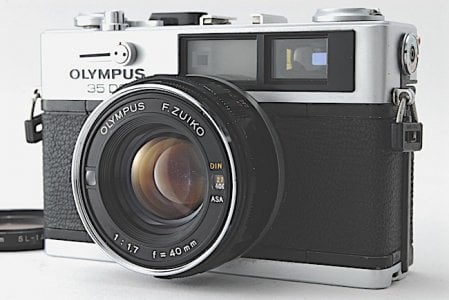
Olympus 35 DC/ has a great 40mm f/1.7 F. Zuiko lens. It's autoexposure only but with a couple of workarounds for enhanced exposure control.
*Canonet G-III 17: Perhaps the best-selling fast lensed compact rangefinder 35 of the modern era (according to Canon over 1.2 million were sold from 1972 to 1982!) it was neglected and undervalued for over a decade but has now regained the respect (and price level) among film shooters that it deserves. Its chief virtues: a superb 6-element, 4-group 40mm f/1.7 Canon lens employing rare earth glass types and focusing down to 2.6 feet, an excellent 0.6x range/viewfinder with a projected, parallax compensating frame line and an aperture readout scale, shutter priority autoexposure using a CdS metering system with its port located at the top of the lens ring so it compensates for mounted filters, a leaf shutter with speeds of ¼ to 1/500 sec plus B, and flash sync at all timed speeds, a large, smooth operating, ergonomically contoured film wind lever, an AE exposure lock, Canon’s very effective quick loading (QL) system, and a flexible auto flash system that works automatically with the Canolite D, and with generic flash units (by guide number and ASA setting) to adjust the flash exposure as you focus the camera. Downsides: the metering system was designed for 1.35v PX 625 mercury cells and must be converted to give accurate readings with current 1.5v cells, and there’s no metered manual mode; you must move the shutter setting off Auto and set f/stops and shutter speeds manually. The Canonet G-III 17 is beautifully made and finished and an awesome shooter. Current price range for a flawless, fully functional example, $75.00 to $150.00 in chrome, and $200.00 to $250.00 in stunning black.
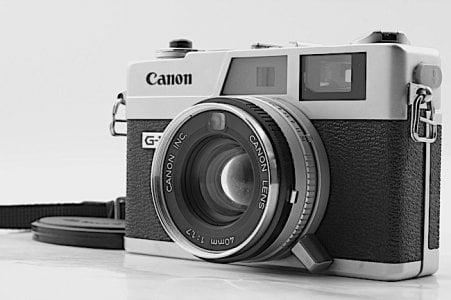
Canonet G-III QL 17. With an array of great feaures and a stellar 40mm f/1.7 Canon lens, it was a great seller when in production, and still is!
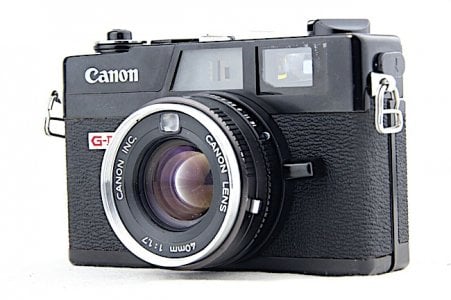
Canonet G-III QL 17 is gorgeous, but pricier, in natty black finish.
Konica Auto S3: In production from 1973 to 1977, this attractive compact autoexposure 35 is acclaimed for its ultra-high-performance 38mm f/1.8 Hexanon lens, a 6-element 4-group semi-wide that earned universal praise for its exceptional sharpness and color correction. Basically a serious upgrade of the landmark Konca C35, with the same outstanding 38mm f/1.8 lens as the short-lived Konica Auto SE of 1966, the Auto S3 added a sophisticated ambient light/flash exposure system that disconnects the metering system from the aperture control and connects it to the focusing system when you slide a flash into the accessory shoe, enabling you to achieve balanced fill flash, a unique capability for a camera in this class. Other cool features: CdS metering system (with meter cell port above the lens, inside the filter ring) provides shutter priority autoexposure, and reads out the camera -selected aperture with an in-finder needle and adjacent f/stop scale, a large, bright range/viewfinder with projected frame line and fixed parallax compensation marks, a Copal automatic inter-lens leaf shutter with flash sync at all speeds from 1/8 to 1/500 sec, plus B, and a hot shoe complemented with a PC outlet. The Auto S3 normally fucuses down to 36 inches, but an optional Auto-Up 3 close-up lets it get down to 19.5 inches. Drawbacks: No manual mode or manual settings, meter system is designed for 1.35v mercury cells and requires modification to give accurate exposures with current 1.5v alkaline or silver-oxide cells, and the shutter still fires when the battery dies, but the lens stays wide open, causing possible overexposures! Despite its limitations the Konica Auto S3 is a great all-around shooter and it’s stunning to behold in black anodized finish, a good thing since, like the Model T Ford, you could “have in any color so long as it’s black!” Prices vary widely, but if you can find one, you can usually snag a clean, fully functional Konica Auto S3 for $125.00 to $250.00.
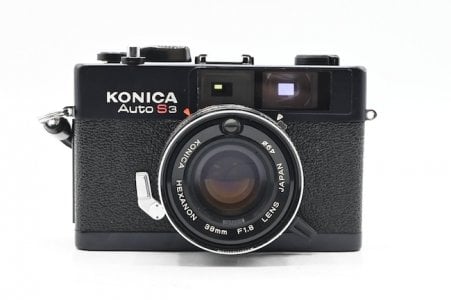
Konica Auto S3 with acclaimed 38mm f/1.8 Hexanon lens. It's beautiful in black, but like the Model T Ford, that was the only color it came in.
*Yashica Electro 35 GX: Released in 1975 it’s one if the first compact rangefinder 35s with an SPD (Silicon Photo Diode) metering system (instead of the CdS cell system used in previous Electro 35s). SPD cells are more sensitive and responsive than CdS cells and have no “memory effect,” the tendency to give erroneous readings when initially taking readings at markedly different light levels. Its 6-element, 4-group 40mm f/1.7 Color-Yashinon DX lens is outstanding, and the GX provides aperture-priority autoexposure from f/1.7 to f/16 using an electronically controlled Copal leaf shutter with stepless speeds of several seconds to 1/500 sec. Its exposure range is a wide EV 0 to EV17, with films ASA 25 to 800, and in-finder red and yellow LED arrows warn of under- and overexposure. The bright, clear 0.62x range/viewfinder has a projected, parallax compensating frame line and crisp central superimposed-image rangefinder patch. Other features: a minimum focus distance of 2.6 feet, smooth single stroke film wind lever, a battery check lamp that doubles as a frame counter illuminator, an X sync hot shoe, and a Yashica Electro Auto Flash System using a dedicated ES-20 Auto Strobe. Downsides: No manual exposure override or settings other than by adjusting the ASA dial, no shutter speed readouts in the finder, and the GX’s metering system was designed for 1.35v mercury batteries and must be converted to provide accurate readings with current 1.5v batteries. Despite these shortcomings the Yashica Electro 35 GX is a superb walkaround shooter’s camera. Fortunately, you can acquire a clean fully functional example for about $80.00 to $150.00 in chrome, or $125.00 to $175.00 in black.
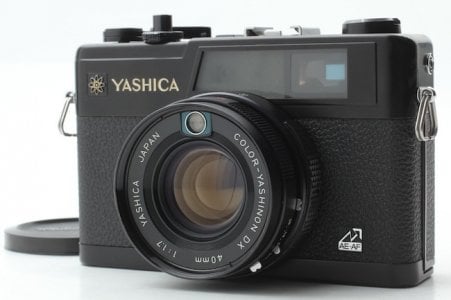
Yashica Electro 35 GX has outstanding 40mmm f/1.7 Color-Yashinon DX lens and pioneered the use of "memory free" SBC meter cells.
Minolta Hi-Matic 7sII: Introduced in 1977, it’s more compact and stylish than previous Hi-Matics and is believed to have been made by Cosina at the behest of Minolta. The camera features a high-performance 6-element, 4-group 40mm f/1.7 Rokkor lens in a Copal inter-lens leaf shutter with speeds of 1/8 to 1/500 sec plus B in Auto or Manual modes. The system provides shutter priority autoexposure plus manual aperture settings from f/1.7 to f/16, and a full range of shutter speed settings (but no metered manual mode). The CdS meter cell, located in the lens surround, automatically compensates for mounted filters, and the metering system covers a range of EV 4.5 to EV 17 and provides film speed settings from ASA 25 to ASA 800. The bright, clear viewfinder has a projected bright frame line with parallax correction marks and displays camera-selected apertures and under/overexposure warnings by needle. The Hi-Matic 7sII focuses down to 2.7 feet, has a hot shoe that provides X sync at all speeds and M sync at 1/30 sec, and a smooth, short throw single stroke wind lever. Downsides: the metering system was designed for a 1.35v mercury battery and must be converted to give accurate readings with current 1.5v alkaline or silver-oxide cells, and no auto parallax compensation. Attractive, well made, straightforward, and highly capable, the Minolta Hi-Matic 7sII is a great walkaround rangefinder 35. Current price range for a clean, fully functional example: $150.00 to $300.00 in chrome or black.
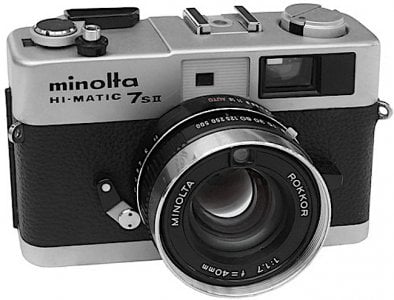
Minolta Hi-Matic 7sII is compact and competent, with a great 40mmm f/1.7 Rokkor lens. It's very pretty too, but used ones are a little pricey.
We’ve covered 18 worthy 35mm rangefinder cameras in this article—whew! All are competent shooters, and some are also collectible classics, but this this hardly exhausts the category, and we urge you to check out the many other fine examples of this once dominant species. However, this should give you a good overview of what’s out there and a clear idea of the assets and liabilities of each model we’ve included. As an incurable camera fanatic, I love them all, but if you’re wondering which ones ae my personal favorites, I’ve marked each one with a star before the camera name. If you have any other candidates, please let me know. Good hunting and good shooting! Film Forever!
Rrangefinder 35s pack maxi picture power into mini form factors!
By Jason Schneider
I wish there were a less ponderous term than “noninterchangeable lens” for describing cameras lacking lens switching capability, but “fixed lens” gives the wrong impression, so I guess we’re stuck with it. The acronym, NIL, doesn’t thrill me either, but I will use it for concision going forward. NIL rangefinder 35s have a noble history going back to the late ‘30s (though some were based on earlier roll film models) and several were offered with f/2 lenses. The species continued in the early postwar years, mostly with light revisions to prewar designs, but now fitted with coated lenses in MX sync shutters, and with other refinements. The apotheosis of this engaging breed burst forth during the ‘60s and ‘70s, with major Japanese companies including Canon, Olympus, Minolta, Konica, and Yashica releasing a slew of amazing NIL rangefinder 35s with fast 6- and 7-element lenses in the f/1.7 to f/2 range and offering such advanced features as autoexposure plus full manual settings, electronically controlled shutters, viewfinders with projected, parallax compensating finder frame lines, and even dual metering modes. Not every model had everything of course, but the performance and versatility of these cameras makes them superb choices for anyone wanting to experience the joys of analog photography without having to spring for a Leica M, a Nikon SP, or a Canon 7sZ. Here’s a brief rundown in (more or less) chronological order:
Note: I’ve placed a little star in front of the names of my personal favorites.
Fast folders: Early NIL rangefinder 35s with f/2 lenses
Weltini I and II: Made by Welta, a German camera maker located in Freital, near Dresden, the Weltini is based on the Welti, a scale focusing, folding 35, but added a coupled range/viewfinder to what would have been the Welti’s bottom plate! The resulting “upside-down Welti” has the advance knob, rewind knob, and frame counter on the bottom, a left-handed shutter release, a swing back hinged on the left, and a film release on the right. The film feeds “backwards” compared to the Welti. One fascinating feature: the Weltini’s focusing lever automatically returns to infinity position as you close the folding bed, neatly preventing potential camera crunching disasters that occasionally occur with other folders.

Prewar Weltini I with uncoated 50mm f/2 Schneider Xenon lens in Compur-Rapid shutter. A great choice for capturing vintage look images.
Twi variants exist: the Weltini I with squared off top range/viewfinder housing (1937 to 1938) and the later, more common version II with a rounded top plate (1938 to 1941). Both have a depth of field table on top, and neither had an accessory shoe. While the design was admittedly “clever” and saved in production costs, many find these cameras “awkward” to use. However, the Weltini is generally acknowledged to be well made, reliable, and capable of capturing excellent images. Most often fitted with an uncoated 50mm f/2.8 Schneider Xenar or Carl Zeiss Jena Tessar, both versions were also available with an uncoated 50mm f/2 Schneider Xenon, a fast, sharp, 6-element, 4-group design that delivers beautiful “vintage look” images. Collectors with deep pockets will keep an eye out for a Weltini with a 50mm f/3.5 Leitz Elmar. You can snag a clean, functional Weltini with a 50mm f/2.8 or 50mm f/2 lens for around $125.00 to $225.00. One with an Elmar will set you back $500.00 to $600.00. Good hunting!

Weltini II with uncoated 50mm f/2 Schneider Xenon lens in Compur-Rapid shutter. It's basically a sleeker more attractive version of the Weltini I.
Certo Dollina II: Certo, a German camera maker based in Johannstadt, a suburb of Dresden, was founded in 1902, and during the ‘20s it produced several well-regarded medium-priced, roll film folding cameras. Responding to the burgeoning interest in 35mm photography, Certo brought forth the Dollina, a horizontal-bed, scale-focusing folding 35 with a simple viewfinder in 1935 and about 2 years later introduced its best-known model the Certo Dollina II, which added a coupled split-image rangefinder with separate viewfinder eyepiece on the top deck. The rangefinder is operated by a cam on the underside of the focusing knob which pushes a stud on the rangefinder body forward as the focus moves toward infinity, a delicate assembly that can easily be knocked out of whack by rough handing. However, when handled with a modicum of respect, the Dollina II, while not the last word in terms of convenience, is an attractive, well-made camera capable of outstanding results. It was available in black enamel finish (early models) or chrome, and in 1938 you could acquire a Certo Dollina II with uncoated 45mm f/2.0 Schneider Xenon lens in a Compur Rapid 1-1/500 sec plus T and B shutter in New York for $57 50. This is equivalent to a staggering $1,246.79 in 2024 dollars, but that was still only about half the price of a Xenon lensed Retina II or Weltini!

Certo Dollina II c. 1937 with uncoated 50mm f/2 Xenon. It was less cnveient (an less expensive) than a Weltini but it has its charms/
The elegantly baroque Certo Dollina III of 1939 was similar in concept to the Dollina II, and available with an uncoated 50mm f/2 Schneider Xenon. The last of the breed, the prewar Super Dollina and the postwar Super Dollina II, had a rounded, more compact body design and were available with an uncoated 50mm f/2 Xenon in a Compur-Rapid shutter and a coated 50mm f/2 Rodenstock Heligon in a Synchro-Compur 1-1/500 shutter. The last run of Super Dollina IIs were often fitted with a coated 50mm f/2.8 Zeiss Jena Tessar lens in an East German Vebur shutter. Prices of a used Certo Dollina (all iterations) vary widely, but you can generally pick up a clean Certo Dollina II with Tessar for $50.00 to $100.00, and a Certo Dollina III with 50mmm f/2.0 Xenon for $150.00 to $300.00; higher for rare mint condition examples.

Certo Dollina III with uncoated 50mm f/2 Schneider Xenon lens in Compur-Rapid shutter. Baroque styling but same specs as the Dollina II.

Late model postwar Super Dollina II with 50mm f/2.8 Jena Tessar lens in 1-1/250 sec pus B Vebur shutter. Note unique focusing knob, top left.
*Kodak Retina II and IIa: Produced by the Nagel factory in Stuttgart, a company acquired by Eastman Kodak Co. in 1931, the Retina name is most closely associated with a long-running series of robust, beautifully made, high-performance folding 35mm cameras, including a full range of models with built-in coupled rangefinders. The first rangefinder Retina was the rare Retina II (Type 122) of 1936 to 1937, which had a built-in, coupled long base rangefinder, a separate viewfinder, and was available with an uncoated 50mm f/2.0 Schneider Xenon lens, a 50mm f/3.5 Kodak Extar, or a 50mm f/2.8 Xenar, all in 1-1/500 sec plus B Compur-Rapid shutters. It was also the first 35mm camera in the world with a top-mounted film wind lever, albeit a short, stubby one, but it proved to be troublesome and the Type 122 was discontinued after only one year of production, and replaced by the much more common Retina II (Type 142), basically the same camera with a conventional wind knob and the same choice of lens/shutter units. The Retina II line continued after the war with the Retina II (type 011) of 1946 to 1949 which features a more convenient combined range/viewfinder with a single eyepiece, a (rare) coated 47mm f/2 Ektar, a (more common) 50mm f/2 Xenon, or a 50mm f/2 Rodenstock Heligon lens that was more commonly fitted to European market cameras. The Retina II (Type 014) of 1949 to 1950 is virtually the same as the Type 011 but adds a PC flash sync terminal. The last of the small-bodied rangefinder Retinas (all subsequent c- and C-series Retina folders had larger, thicker bodies) was the Retina IIa (Type 016), manufactured from 1951 to 1954. It was originally fitted with a Compur-Rapid shutter, but the more common later version features a Syncrho-Compur 1-1/500 sec plus B shutter with MX sync. The postwar Retina IIa’s signature feature is a top-mounted single stroke film wind lever, and that’s one reason many savvy users consider the 50mm f/2 Xenon-lensed version of the Retina IIa the best folding rangefinder Retina ever. Others note that the IIa’s frame counter is delicate and hard to repair (since parts are no longer available) and claim thar the knob wind Retina II (Type 014) is more reliable. They’re both great user collectibles capable of first-rate performance so you pay your money and take your choice!

Rare Kodak Retina II, (Type 122), top view, showing innovative stubby wind lever. it was replaced by more reliable (Type 142) with knob wind.

Kodak Retina IIa with coated 50mm f/2 Schneider Xenon. Many say it's the best of the breed, combining compactness and high performance.
Clean Kodak Retina II cameras (all versions except for the Type 122) are widely available in clean working condition at prices ranging from $60.00 to $125.00 (up to $225 fir mint examples) and are among the best buys for vintage film shooters. Pristine Retina II’s sporting the rare (and superb) 47mm f/2 Ektar lens are collector’s prizes that go for $500 on up, and since there are only about 200-300 known examples of the Retina II (Type 122). prices run around $800.00 to $1,200.00 when they show up online. Note: If compactness and lens speed are not that important to you, the bulkier Retina IIc and IIC (no meter, available with the superb 50mm f/2.8 Xenon or Heligon lens) are great shooters as are the Retina IIIc and IIIC both with component interchangeable lenses, built-in uncoupled selenium meters, and typically fitted with 50mm f/2 Xenon lenses. The Retina IIIC (large C) of 1957-1961, the last of the folding Retinas, has an excellent high magnification multi-frame viewfinder (all 3 reflected frame lines are visible at once). Like all c- and C-series models it’s chunky but a great shooter. Current estimated used price ranges: Retina IIc, $50.00 to $100.00; Retina IIC (rare), $75.00 to $135.00; Retina IIIc with 50mm f/2 Xenon, $90.00 to $140/00: Retina IIIC with 50mm f/2 Xenon, $250.00 to $350.00.

Uncommon Kodak Retina IIC (large C) with superb 50mm f/2.8 Schneider Xenon lens in Synchro-Compur shutter. It's a keeper!
Agfa Karat 36: Based on the postwar version of the Karat 12, a folding camera with a split-image rangefinder that took Agfa Rapid cartridges, the Karat 36, released in 1948 and in production in the ‘50s, takes regular 35mm film cartridges, and provides a standard 24 x 36mm format. Like the Karat 12’s it has a unique full image area split-image rangefinder, a small bellows behind the lens unit, and extends the font standard to shooting position on two robust spring-loaded scissors struts. It added a rewind knob, employs an unusual “imbedded” film advance lever with a front-to-back motion, and was available with a choice of 5 lenses, a 4-element 50mm f/2.8 Agfa Solinar, a 50mm f/2.8 Schneider Xenar, or a 6-element 50mm f/2 Schneider Xenon, Agfa Solagon, or Rodenstiok Heligon, all fine performers, each with slightly different rendition. Early examples of the Karat 36 have Compur-Rapid shutters with X sync; later ones are fitted with Synchro-Compur shutters with MX sync; both provide speeds of 1-1/500 sec plus B. In 1954 Agfa released the Agfa Karat IV, which has a conventional superimposed image range/viewfinder, a Prontor SVS shutter with a top speed if 1/300 sec, and the same choice of lenses except for the 50mm f/2.8 Xenar, which was evidently dropped on that model.
All these Agfas are beautifully made and finished, fitted with fine lenses, and capable of outstanding on-film oerfirmance. Used ones are somewhat more likely than, say, Retinas to require repairs, so make sure the one you buy is fully functional and that the seller offers return privileges with a full refund if you’re not satisfied. You can generally snag a clean working Karat 36 or Karat IV with 50mm f/2.8 Solinar or Xenar lens for $50.00 to $100.00, and one with a 50mm f/2 Xenon for around $125.00 to $150.00. Examples with 50mm f/2 Solagon or Heligon lenses generally fetch about $200.00. Note: These cameras were also marketed under the Ansco brand, with inscriptions noting that they were made in Germany by Agfa. The Karat 36 was also sold as the Karomat, and suitably inscribed on the top.

Agfa Karat 36 with coated 50mm f/2.0 Schneider Xenon lens in Compur-Rapid shutter. It had an unusual full-area split-image rangefinder.

Agfa Karat IV with 50mm f/2.8 Solinar lens in Prontor-SVS shutter. It has a superimposed-image rangefinder in a Karat-style folding body.
Zeiss Tenax II: If your taste runs to the exotic, the Tenax II (model 580/27) of 1938 may be the compact fast lensed rangefinder 35 for you. Though technically this 24 x24mm format beauty is an interchangeable lens camera, very few accessory lenses were made or sold. Optimized for shooting fast sequences you push the large right-handed, front-mounted wind lever downward with your index finger like a plunger, let it spring back, then quickly move your finger back slightly and press the nearby shutter release to take the picture. This fast-firing design, inspired by the spring motor 24 x 24mm Robot I of 1934, was patented by eminent Zeiss camera designer Hubert Nerwin and his team. Other ingenious features: a combined range/viewfinder that moves the secondary image by means of two contra-rotating prism wedges in front of the rangefinder window (like a Zeiss Super Ikonta), and a behind-the-lens Compur Rapid OS leaf shutter with speeds of 1 to 1/400 sec plus B. Standard lenses for the Texax II were an uncoated 4cm f/2 Sonnar or 4cm f/2.8 Tessar, and there was a rare 2.7cm f/4.5 Orthometar wide-angle and a low-prduction7.5cm f/4 Sonnar medium tele, all in a unique bayonet mount. The Tenax II is a collector’s prize but also a highly competent picture taker. As you’d expect a clean working Tenax II with a 4cm f/2 Sonnar ir f/2.8 Tessar runs about $600.00 to $800.00, and one with a 2.7cm f/4.5 Orthometar (a mere 302 units were produced!) fetches $2,200.00 to $4,000.00.

Zeiss Tenax II with 4cm f/2 Sonnar. An awesome fast-firing design with 24 x24mm format, this exotic is technically an interchangeable-lens 35.
*Minolta V2: Named to evoke Wernher von Braun’s iconic V2 rocket, the 1958 Minolta V2’s signature feature was its unique Optiper-Citzen-HS M-10 leaf shutter that provides unprecedented top speeds of 1/1000 and 1/2000 sec at maximum apertures if f/4 and f/8 respectively. The shutter design uses stronger springs to increase the speed of the shutter blades and restricts the overlap of the blades to enable elevated shutter speeds, but only at smaller apertures. The shutter also provides a normal shutter speed range of 1 to 1/500 sec plus B over the full aperture range (f/2 to f/22) of the excellent 6-element, 5-group 45mm f/2 Rokkor-PF lens. The sleekly curvilinear V2 has manual settings only—there’s no built-in meter—but it does offer an excellent combined, coincident type range/viewfinder with a projected parallax compensating frame line in the finder, a nicely contoured film wind lever, was claimed to be the first camera with an LVS system that goes up to 20, and has a dimpled pressure plate to reduce friction, All this was offered at the enticing price of only $99.95 (equal to about $1,066.00 in 2024 dollars). In 1960 the Minolta V2 was succeeded by the Minolta V3 which added a small built-in uncoupled selenium meter shoehorned into the area around the rangefinder window and upped the top shutter speed to 1/3000 sec (but still only at apertures of f/8 or smaller). All other features closely parallel the V2. If you’re tempted, you can acquire either one of these fascinating and adept user collectibles. A Minolta V2 in clean working condition runs about $75.00 to $150.00; the much rarer V3 fetches $200.00 to $250.00.

Minolta V2 with 45mm f/2 Rokkor-PF lens has a 1/2000 sec top shutter speed, but it's only available at apertures f/8 and smaller! (see text)

Rare Minolta V3 has built-in selenium cell meter and a 1/3000 sec top shutter speed, but (you guessed it!) its only useable at f/8 and smaller.
*Topcon 35-S and 35-L: These outstanding NIL rangefinder 35s were produced by Tokyo Kogaku (Tokyo Optical Co.) from 1956 to late 1959. The Topcon 35-S was released in 1956 and was in production for only about a year, Ruggedly handsome and straightforward, it ports a superb semi-wide-angle 44mm f/2 Topcor lens (a classic 6-element 4-grouo Double Gauss design) in a Seikosha-MX 1-1/500 sec plus B leaf shutter, features a combined 1:1 range/viewfinder with a parallax-compensating Albada frame line, and has a top-mounted double-stroke wind lever claimed to minimize torn sprocket holes. Very well made, nicely finished and reliable, it has definite collector appeal and is also a fine choice for vintage film shooters.

Topcon 35-S. with 4.4cm f.2 Topcor lens in Seikosha MX Shutter. No meter, but a great lens and range/viewfinder and very robust build quality.

Topcon 35-L. It added a Seikosha-MXL shutter with the then-new LVS coupling system that many vintage camera shooters love to hate.
The Topcon 35-S was replaced by the Topcon 35-L (marketed in the USA as the Beseler Topcon 35-L) in 1957. Its specs are the same as the 35-S except that the shutter was upgraded to the Seikosha-MXL, which featured the then-new LVS coupling system. It was sold with a separate selenium meter that gave readings in Light Value numbers. An economy model, the Topcon 35-JL with a 50mm f/2.8 Topcor lens (a 5-element, 3-group Heliar design) was introduced at the same time as the 35-L, and both were discontinued by the end if 1959, marking the end of Tokyo Optical Co.’s brief foray inti the 35mm rangefinder market. You can acquire one if these fine and distinctive user collectibles in clean working condition for around $100.00 to $150.00.

Fujica 35-SE with 4.5cm f/1.9 lens and built-in selenium meter. "1000 1.9" logo below lens marks it as variant with 1/1000 sec top speed.
Fujica 35-SE: A very advanced rangefinder 35 for 1959, it was basically an update of the landmark Fujica 35-ML and retained that camera’s distinctive (and ergonomic) thumbwheel focusing, baseplate film wind lever and side-mounted rewind crank (it’s on the upper left-hand corner with the camera held in shooting position). It has what Fuji described as an “automatic exposure setting electronic light meter,” but that’s just ad lingo for a built-in coupled selenium cell meter that uses a manual “center the needle” system with a top-mounted meter scale. You can grab the aperture and shutter speed rings on the lens barrel and rotate them simultaneously to maintain the same EV. Other key features: large, bright range/viewfinder with projected parallax compensating frame line and excellent central superimposed image rangefinder, outstanding 6-element, 4-group 45mm f/1.8 Fujinon lens in a Fuji Synchro-MXL shutter with a top speed of 1-1/500 sec or 1/1000 sec plus B (there were 2 versions). It’s a fine camera, beautifully made, and with a great lens, but you’ll be lucky to find one with a working meter. Current price range in clean condition with working shutter: $40.00 to $85.00.
Autoexposure rangefinder 35s: Last and most convenient of the breed!
Canonet: The original Canonet of 1961 often gets overlooked in the glitz and glamour of later models like the acclaimed Canonet G-III 17 of 1972, but it was remarkably adept and full featured for its day and set the stage for a generation of compact autoexposure rangefinder cameras that flourished in the ‘70s. Its signature feature is a selenium meter cell placed concentrically around the excellent Canon SE 45mm f/1.9 lens (a 5-element, 4-group Gauss design). Its Copal SLV leaf shutter with speeds from 1 sec. to 1/ 500 plus B&T locks automatically if the light is too low/high, and the camera has a built-in self-timer, and a combined range/viewfinder with a projected parallax-compensating frame line. Beautifully proportioned and very well made, the original Canonet provides shutter priority AE and full manual settings (there’s no metered manual mode) with aperture scale in the viewfinder. Its trigger-style wind lever and rewind crank located unconventionally on the bottom of the body, but this setup works well. Shooters should make sure the camera they buy has film speed settings from ASA 10 to 400 (early examples only go up to ASA 200!). Marks of this camera’s success: initial stocks were sold out in 2 hours after it was released, and within 2-1/2 years a million Canonets had been sold! The original Canonet is a great shooter when it’s working and you can often snag a clean one for $50.00 or even less, but repairs can be costly so caveat emptor.

Canonet original, with selenium cell around the 45mm f/1.9 SE Canon lens. This is the dual logo version marketed in the U.S. by Bell & Howell.
The Fujica V2: Released in 1964, this hefty, beautifully made rangefinder 35 is basically an upgraded Fujica 35-SE with the same outstanding 6-element, 4-group 45mm f/1.8 Fujinon lens, thumbwheel focusing down to 3 feet, bottom-mounted wind lever, side mounted rewind crank and great range/viewfinder with a projected parallax compensating frame line and clear coincident-type central rangefinder patch. But instead of a center-the needle, coupled selenium meter, the V2 has a front-mounted CdS metering port set in the distinctive 25 to 400 ASA dial (so it doesn’t automatically compensate for mounted filters), and provides shutter priority autoexposure plus full manual settings, albeit with no in-finder readouts. A red exposure indicator lights up if either or both settings are outside the metering range. The inter-lens leaf shutter is either a Citizen with speeds of 1 to 1/500 sec plus B, or a Citizen MLT with a top speed of 1-1/1000 sec plus B. It’s a superb user/collectible with only 2 downsides: its metering system was designed to take 1.35v PX 13 mercury batteries and must be converted to provide accurate readings with current 1.5v cells, and (inexplicably) the film speed settings top out at a measly ASA 400. If you want to acquire one if these gems in clean working order, be prepared to shell out about $100.00.

Fujica V2 has a superb 45mm f/1.8 Fujinon lens, thumbwheel focusing, many advanced features, but film speed settings top out at ASA 400?!
Olympus 35 SP: Released in 1969 this audacious rangefinder 35 is the only camera of its kind with dual pattern (center-weighted averaging and spot metering) and is one of the few that provides both shutter priority autoexposure and metering in manual mode—the uncoupled CdS cell meter provides EV readings in the finder which are then translated into shutter speed- and aperture-setting rings on the barrel of the superb 52mm f/1.7 G. Zuiko lens, an advanced 7-element, 4-group design. Apertures range from f/1.7 to f/22 in AE mode and f/1.7 to f/16 in manual mode, the shutter provides speeds of 1 to 1/500 sec plus B with flash sync at all speeds, there’s a handy exposure lock actuated by a half press of the shutter release, and the large, bright range/viewfinder has a crisp frame line with parallax correction marks, but no auto parallax compensation. The lens focuses smoothly down to 2.79 feet using a large, convenient focusing lever, the film speed scale has settings from ASA 25 to 800, and the camera provides accurate auto flash as you focus once you set the film speed and flash guide number. Downsides: Manual metering is inconvenient; the CdS meter cell next to the viewfinder doesn’t automatically compensate for munted filters, the metering system was designed for 1.35v PX 625 mercury cells and must be modified to work properly with current 1.5v batteries, and the meter is only sensitive down to EV3 and locks up when the chosen shutter speed is below 1/15 sec or higher than 1/250 sec. Despite its relatively minor foibles the trendsetting Olympus 35SP is an awesome picture taker and a remarkable achievement for a camera that debuted 55 years ago--and it’s attractive to boot. You can acquire a clean, fully functional example for about $125.00 to $200.00 in silver, about 50 bucks higher in beautiful black.

Olympus 35 SP with superb 7-element 42mm f/1.7 G.Zuiko lens had dual mode metering, many more advanced features way back in 1969!

Olympus 35 SP is beautiful in black, but it was produced in smaller quantities and fetches higher prces than the chrome version.
Yashica Electro 35 CC: Released In 1970, it was the only compact rangefinder 35 with a fast true wide-angle lens, a sharp 6-element 4-group 35mm f/1.8 Yashinon DX in an electronically controlled inter-lens leaf shutter with speeds of 8 to 1/250 sec and built in X sync visa the PC outlet only (no hot shoe). The camera provides aperture priority automation using a CdS cell in the lens I.D. ring, thereby automatically compensating for mounted filters, and has under- and over-exposure wanning lights in the finder, but no aperture or shutter speed readouts or manual settings. More compact than the more common Electro 35 GS and GT, the 35 CC has very clear projected finder frame line with markings for parallax compensation, ASA settings from 25 to 500, an excellent short stroke wind lever, a crisp, clear superimposed image rangefinder, and its lens focuses down to a closer than average 2.6 feet. On the downside, flash sync is at 1/30 sec. On the plus side: the metering system is powered by a readily available 6v PX28 battery. In the immortal words of the old Konica ad, “the lens alone is worth the price,” and this stellar high-speed wide-angle goes a long way in compensating for this black beauty’s limitations. Note: Some examples were labeled Yashica Electro 35 CCN Wide). Prices vary widely, but you can generally acquire a clean working example for $75.00 to $150.00.

Yashica Elecro 35 CC in black with outstanding wide-angle 35mm f/1.8 Color-Yashinon DX lens is an affordable high-performance classic.
Olympus 35 DC: Introduced in 1971, this is the programmed autoexposure sister of the acclaimed Olympus 35 RD and fortunately it has the same great 6-element, 4-group 40mm f/1.7 F. Zuiko lens. To partially compensate for the camera’s lack of manual settings, the DC provides a Back Light Compensation (BLC) button on the back that confines the metering area to the rangefinder patch and locks in the exposure reading by partially depressing the shutter release. Other key features: projected frame line viewfinder with parallax compensation markings, well defined central coincidence type rangefinder with focusing to 2.8 feet, and combined aperture and shutter speed readouts. The Seiko infinite program shutter provides exposures ranging from 1/15 sec at f/1.7 to 1/500 sec at f/16, focus controlled auto flash with daylight sync is available, film speed settings range from ASA 25 to ASA 800. Other useful features: an Olympus easy loading system, a short throw ratchetted single-stroke wind lever, and a built-in self-timer. The Olympus 35 DC’s CdS metering system was designed to be powered by a 1.35v PX 625 mercury battery and must be modified to provide accurate readings with current 1.5v batteries. You can acquire one if these adept, pleasantly compact shooters in clean working condition for about $100.00 and they occasionally show up at asking prices roughly half that amount. Good hunting!

Olympus 35 DC/ has a great 40mm f/1.7 F. Zuiko lens. It's autoexposure only but with a couple of workarounds for enhanced exposure control.
*Canonet G-III 17: Perhaps the best-selling fast lensed compact rangefinder 35 of the modern era (according to Canon over 1.2 million were sold from 1972 to 1982!) it was neglected and undervalued for over a decade but has now regained the respect (and price level) among film shooters that it deserves. Its chief virtues: a superb 6-element, 4-group 40mm f/1.7 Canon lens employing rare earth glass types and focusing down to 2.6 feet, an excellent 0.6x range/viewfinder with a projected, parallax compensating frame line and an aperture readout scale, shutter priority autoexposure using a CdS metering system with its port located at the top of the lens ring so it compensates for mounted filters, a leaf shutter with speeds of ¼ to 1/500 sec plus B, and flash sync at all timed speeds, a large, smooth operating, ergonomically contoured film wind lever, an AE exposure lock, Canon’s very effective quick loading (QL) system, and a flexible auto flash system that works automatically with the Canolite D, and with generic flash units (by guide number and ASA setting) to adjust the flash exposure as you focus the camera. Downsides: the metering system was designed for 1.35v PX 625 mercury cells and must be converted to give accurate readings with current 1.5v cells, and there’s no metered manual mode; you must move the shutter setting off Auto and set f/stops and shutter speeds manually. The Canonet G-III 17 is beautifully made and finished and an awesome shooter. Current price range for a flawless, fully functional example, $75.00 to $150.00 in chrome, and $200.00 to $250.00 in stunning black.

Canonet G-III QL 17. With an array of great feaures and a stellar 40mm f/1.7 Canon lens, it was a great seller when in production, and still is!

Canonet G-III QL 17 is gorgeous, but pricier, in natty black finish.
Konica Auto S3: In production from 1973 to 1977, this attractive compact autoexposure 35 is acclaimed for its ultra-high-performance 38mm f/1.8 Hexanon lens, a 6-element 4-group semi-wide that earned universal praise for its exceptional sharpness and color correction. Basically a serious upgrade of the landmark Konca C35, with the same outstanding 38mm f/1.8 lens as the short-lived Konica Auto SE of 1966, the Auto S3 added a sophisticated ambient light/flash exposure system that disconnects the metering system from the aperture control and connects it to the focusing system when you slide a flash into the accessory shoe, enabling you to achieve balanced fill flash, a unique capability for a camera in this class. Other cool features: CdS metering system (with meter cell port above the lens, inside the filter ring) provides shutter priority autoexposure, and reads out the camera -selected aperture with an in-finder needle and adjacent f/stop scale, a large, bright range/viewfinder with projected frame line and fixed parallax compensation marks, a Copal automatic inter-lens leaf shutter with flash sync at all speeds from 1/8 to 1/500 sec, plus B, and a hot shoe complemented with a PC outlet. The Auto S3 normally fucuses down to 36 inches, but an optional Auto-Up 3 close-up lets it get down to 19.5 inches. Drawbacks: No manual mode or manual settings, meter system is designed for 1.35v mercury cells and requires modification to give accurate exposures with current 1.5v alkaline or silver-oxide cells, and the shutter still fires when the battery dies, but the lens stays wide open, causing possible overexposures! Despite its limitations the Konica Auto S3 is a great all-around shooter and it’s stunning to behold in black anodized finish, a good thing since, like the Model T Ford, you could “have in any color so long as it’s black!” Prices vary widely, but if you can find one, you can usually snag a clean, fully functional Konica Auto S3 for $125.00 to $250.00.

Konica Auto S3 with acclaimed 38mm f/1.8 Hexanon lens. It's beautiful in black, but like the Model T Ford, that was the only color it came in.
*Yashica Electro 35 GX: Released in 1975 it’s one if the first compact rangefinder 35s with an SPD (Silicon Photo Diode) metering system (instead of the CdS cell system used in previous Electro 35s). SPD cells are more sensitive and responsive than CdS cells and have no “memory effect,” the tendency to give erroneous readings when initially taking readings at markedly different light levels. Its 6-element, 4-group 40mm f/1.7 Color-Yashinon DX lens is outstanding, and the GX provides aperture-priority autoexposure from f/1.7 to f/16 using an electronically controlled Copal leaf shutter with stepless speeds of several seconds to 1/500 sec. Its exposure range is a wide EV 0 to EV17, with films ASA 25 to 800, and in-finder red and yellow LED arrows warn of under- and overexposure. The bright, clear 0.62x range/viewfinder has a projected, parallax compensating frame line and crisp central superimposed-image rangefinder patch. Other features: a minimum focus distance of 2.6 feet, smooth single stroke film wind lever, a battery check lamp that doubles as a frame counter illuminator, an X sync hot shoe, and a Yashica Electro Auto Flash System using a dedicated ES-20 Auto Strobe. Downsides: No manual exposure override or settings other than by adjusting the ASA dial, no shutter speed readouts in the finder, and the GX’s metering system was designed for 1.35v mercury batteries and must be converted to provide accurate readings with current 1.5v batteries. Despite these shortcomings the Yashica Electro 35 GX is a superb walkaround shooter’s camera. Fortunately, you can acquire a clean fully functional example for about $80.00 to $150.00 in chrome, or $125.00 to $175.00 in black.

Yashica Electro 35 GX has outstanding 40mmm f/1.7 Color-Yashinon DX lens and pioneered the use of "memory free" SBC meter cells.
Minolta Hi-Matic 7sII: Introduced in 1977, it’s more compact and stylish than previous Hi-Matics and is believed to have been made by Cosina at the behest of Minolta. The camera features a high-performance 6-element, 4-group 40mm f/1.7 Rokkor lens in a Copal inter-lens leaf shutter with speeds of 1/8 to 1/500 sec plus B in Auto or Manual modes. The system provides shutter priority autoexposure plus manual aperture settings from f/1.7 to f/16, and a full range of shutter speed settings (but no metered manual mode). The CdS meter cell, located in the lens surround, automatically compensates for mounted filters, and the metering system covers a range of EV 4.5 to EV 17 and provides film speed settings from ASA 25 to ASA 800. The bright, clear viewfinder has a projected bright frame line with parallax correction marks and displays camera-selected apertures and under/overexposure warnings by needle. The Hi-Matic 7sII focuses down to 2.7 feet, has a hot shoe that provides X sync at all speeds and M sync at 1/30 sec, and a smooth, short throw single stroke wind lever. Downsides: the metering system was designed for a 1.35v mercury battery and must be converted to give accurate readings with current 1.5v alkaline or silver-oxide cells, and no auto parallax compensation. Attractive, well made, straightforward, and highly capable, the Minolta Hi-Matic 7sII is a great walkaround rangefinder 35. Current price range for a clean, fully functional example: $150.00 to $300.00 in chrome or black.

Minolta Hi-Matic 7sII is compact and competent, with a great 40mmm f/1.7 Rokkor lens. It's very pretty too, but used ones are a little pricey.
We’ve covered 18 worthy 35mm rangefinder cameras in this article—whew! All are competent shooters, and some are also collectible classics, but this this hardly exhausts the category, and we urge you to check out the many other fine examples of this once dominant species. However, this should give you a good overview of what’s out there and a clear idea of the assets and liabilities of each model we’ve included. As an incurable camera fanatic, I love them all, but if you’re wondering which ones ae my personal favorites, I’ve marked each one with a star before the camera name. If you have any other candidates, please let me know. Good hunting and good shooting! Film Forever!
Attachments
Last edited:
Zuiko-logist
Well-known
I would add the Minolta Himatic E - lovely 40mm f1.7 lens and automatic exposure like the Olympus 35DC.
Last edited:
Great list! To add to this, a few I’ve owned: Oly 35RD although every copy I’ve owned had sticky shutter syndrome. Not sure if the 35DC is also prone to this.
Vivitar 35ES (black paint!)
Konica Auto S2. First 35mm I ever owned, acquired when I was 14. Still have it and it still works. Great lens and viewfinder with adjusting frame lines but larger than other similar RFs.
Vivitar 35ES (black paint!)
Konica Auto S2. First 35mm I ever owned, acquired when I was 14. Still have it and it still works. Great lens and viewfinder with adjusting frame lines but larger than other similar RFs.
Jason Schneider
the Camera Collector
The Minolta Hi-Matic E has CdS-meter programmed autoexposure and a Seiko leaf shutter controlled by the meter with an AE range of EV0.5=F1.7 & 2sec., and EV17=F11 & 1/1000 sec. It’s a very nice machine that, like others on my list, lacks manual settings or manual exposure readouts, but it performs very well and has a great lens. I did not “omit “ it, but as I noted at the end of the article, I couldn’t include everything, and this is one excellent example. Thanks for your input.
CMur12
Well-known
Thanks for another great and informative article, Jason.
I've had a couple of Olympus 35 RCs, a Vivitar 35 ES (black paint), and a couple of Canonet G-III QL 17s. These served me as ideal travel cameras.
- Murray
I've had a couple of Olympus 35 RCs, a Vivitar 35 ES (black paint), and a couple of Canonet G-III QL 17s. These served me as ideal travel cameras.
- Murray
Zuiko-logist
Well-known
Many thanks! All the above are excellent cameras.The Minolta Hi-Matic E has CdS-meter programmed autoexposure and a Seiko leaf shutter controlled by the meter with an AE range of EV0.5=F1.7 & 2sec., and EV17=F11 & 1/1000 sec. It’s a very nice machine that, like others on my list, lacks manual settings or manual exposure readouts, but it performs very well and has a great lens. I did not “omit “ it, but as I noted at the end of the article, I couldn’t include everything, and this is one excellent example. Thanks for your input.
Jason Schneider
the Camera Collector
Thanks for your kind words, and your additions. I’m not familiar with the Vivitar, but they marketed some good lenses and cameras. I do believe the Konica Auto S2 is on the large side. and that’s the main reason I didn’t include it. Good shooting!Great list! To add to this, a few I’ve owned: Oly 35RD although every copy I’ve owned had sticky shutter syndrome. Not sure if the 35DC is also prone to this.
Vivitar 35ES (black paint!)
Konica Auto S2. First 35mm I ever owned, acquired when I was 14. Still have it and it still works. Great lens and viewfinder with adjusting frame lines but larger than other similar RFs.
I have a number of these, glad to see they are on the list.
One to mention- the Walz 35 Envoy, with 4.8cm F1.9- a 7 element Sonnar formula lens. One of the few fixed-lens rangefinders with a Sonnar type lens.
Easy to recognize- the lens diagram is engraved on the top deck.
One to mention- the Walz 35 Envoy, with 4.8cm F1.9- a 7 element Sonnar formula lens. One of the few fixed-lens rangefinders with a Sonnar type lens.
Easy to recognize- the lens diagram is engraved on the top deck.
titrisol
Bottom Feeder
Godfrey
somewhat colored
The Kodak Retina IIIc has a lovely Schneider 50mm f/2 lens, with interchangeable front element optics for 35mm and 85mm alternatives. I have a bit of a special ... A Retina IIIc but fitted with a IIc top cover, sans meter: one of my favorite cameras! (It happened when I bought a cheap, $25, IIIc that worked beautifully but had a bad meter and a dent in the top cover which prevented using the accessory shoe. An even cheaper IIc, $10, that needed a shutter and film transport overhaul provided the clean cover and the other two bits that sit under the cover to complete the conversion...  )
)
G
G
Evergreen States
Pierre Saget (they/them)
My Canonet G-III QL17 shutter has stuck twice and I've been reluctant to send it to get repaired. Love the lens. Hate the focus tab. I should probably get it repaired again, shoot 10-15 rolls to get my money's worth out of the repairs and then sell it off. I have an Olympus 35RC that I like a lot better. Slower lens, finicky aperture ring, no shutter speeds slower than 1/15th, no real-time parallax corrected frame lines and a frame overlap issue on mine, but still a wonderful camera.Great list! To add to this, a few I’ve owned: Oly 35RD although every copy I’ve owned had sticky shutter syndrome. Not sure if the 35DC is also prone to this.
The Vivitar 35ES is a black painted small RF very similar to the Auto S3 or the 7sii. The three are quite different internally but feature-wise close enough that some claim they were all built in the same factory.
The most solidly built of the fixed lens RFs of this era is the Canonet QL17 GIII, IMHO. It’s heavier than these other lightweights, and a clean copy of the QL has a magnificent viewfinder with parallax corrected frames.
The 35ES has a lower magnification vf with quite a bit of barrel distortion.
The S3 isn’t parallax corrected but has an ingenious automatic fill flash system activated by a little switch in the hot shoe.
The most solidly built of the fixed lens RFs of this era is the Canonet QL17 GIII, IMHO. It’s heavier than these other lightweights, and a clean copy of the QL has a magnificent viewfinder with parallax corrected frames.
The 35ES has a lower magnification vf with quite a bit of barrel distortion.
The S3 isn’t parallax corrected but has an ingenious automatic fill flash system activated by a little switch in the hot shoe.
das
Well-known
Jason Schneider
the Camera Collector
Thanks for your thoughts. I believe Walz Envoy with the 7-element 4.8cm f/1.9 Kominar lens was made by Nitto. The only one I’ve handled was a model M-35 with a built-in selenium meter and I agree it’s a very nice camera. Most of the ones I’ve seen on the online auction sites were offered by Japanese sellers and relatively few were sold in the USA.I have a number of these, glad to see they are on the list.
One to mention- the Walz 35 Envoy, with 4.8cm F1.9- a 7 element Sonnar formula lens. One of the few fixed-lens rangefinders with a Sonnar type lens.
Easy to recognize- the lens diagram is engraved on the top deck.
hilltime
Well-known
Another great information filled article. I have a number of these cameras and my faves are the Topcon 35S and 35 L models. The 4.4cm/F2 Topcor lens is fantastic and delivers the quality of all the Topcors used by the Leotax RF cameras. The one thing I don't really care for is the double stroke film advance, but again I guess they did this for the reason of less stress on the film. I have acquired a couple of the meters and the original lens shade and consider these little gems some of the best P/S cameras ever made.
Also have to give a nod to the Olympus SP and the Yashica CC for it's 35mm/F1.8 lens.
Also have to give a nod to the Olympus SP and the Yashica CC for it's 35mm/F1.8 lens.
Dralowid
Michael
When I was in my 'collecting period' 35mm folders (with the exception of Retinas) were much cheaper that their larger format brethren.
I haven't looked of late...but...
I haven't looked of late...but...
Muggins
Junk magnet
I find Jason to be the dietary fibre of TFF, in that so often he gives me terrible GAS. And he's given me it again!
More seriously, I enjoyed reading that very much. I have a Retina II, can't remember which model, and an Oly 35RC which are as close as I get to any on the list.
The Certo Dollina reminded me of the Certo Dolly I have which has a very odd shutter release on the end of a long piece of wire. I have at least one other 1930s camera with an equally awkward release, maybe a future article could be "WTF were the designers thinking when they put the release there?". Mind you, some learnt quickly I have a just past WW2 Bessa with a sort of pistol trigger release that I think is the nicest to use of any of my folders.
Sorry, I digress!
More seriously, I enjoyed reading that very much. I have a Retina II, can't remember which model, and an Oly 35RC which are as close as I get to any on the list.
The Certo Dollina reminded me of the Certo Dolly I have which has a very odd shutter release on the end of a long piece of wire. I have at least one other 1930s camera with an equally awkward release, maybe a future article could be "WTF were the designers thinking when they put the release there?". Mind you, some learnt quickly I have a just past WW2 Bessa with a sort of pistol trigger release that I think is the nicest to use of any of my folders.
Sorry, I digress!
Dralowid
Michael
Shutter release linkages on folding cameras with the shutter button on the body and the shutter at the other end of the camera are a weak point to put it mildly, add to that some sort of early method of preventing double exposure when the film advance is separate from the shutter cocking routing and...well you know the rest.
An afterthought...front cell focussing or 'unit' focussing, does it really make that much of a difference?
An afterthought...front cell focussing or 'unit' focussing, does it really make that much of a difference?
Don't forget about the Auto SE. 38mm f/1.8 Hexanon, same lens as the S3 but can RF coupled focus down to 0.6m.. My favorite p&s rangefinder.
I would like to try one of these but they aren't that easy to find!
das
Well-known
I would like to try one of these but they aren't that easy to find!
Yeah, I don't think they sold too well as they were very expensive at the time. They pop up on the auction sites here and there. I think that Japan has some supply of them as well.
Share:
-
This site uses cookies to help personalise content, tailor your experience and to keep you logged in if you register.
By continuing to use this site, you are consenting to our use of cookies.


